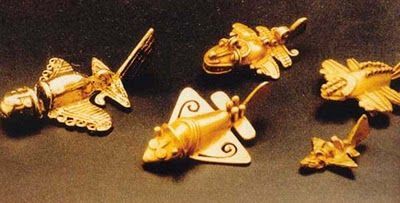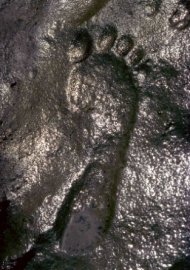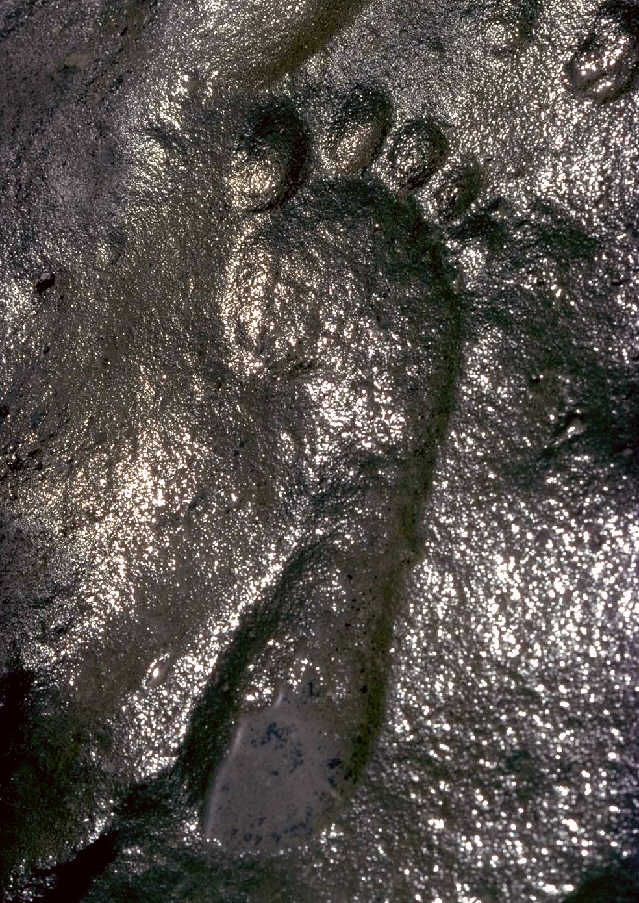It looks like you're using an Ad Blocker.
Please white-list or disable AboveTopSecret.com in your ad-blocking tool.
Thank you.
Some features of ATS will be disabled while you continue to use an ad-blocker.
share:
Greetings, ATS!
Today I bring you another set of mysteries….objects discovered “out of time.” In other words, objects found in seemingly impossible circumstances that would date the object to antiquity or imply contact between nations before known contact existed. Before I began, let me assure you that yes, I’m aware these objects have been discussed before on ATS. However, this thread is meant to be a summary of these unusual objects and to provide an opportunity for our newer members to learn about them.
First up…The Antikythera Mechanism
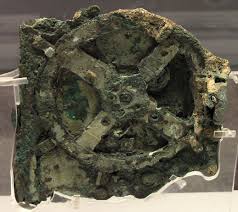
The Antikythera Mechanism was discovered in 1901 in the wreckage of a ship off the isle of Antikythera. The ship supposedly sank in 87
BCE, and is believed to be of Greek origin. The Mechanism is thought to have been used to calculate the movement of the moon and stars. Some have even called it the “first analog computer known to man.”
There is no question about the authenticity of the Antikythera Mechanism, and scientists continue to study it today.
Next up….The Goddard Norse Coin (aka the Maine Penny)
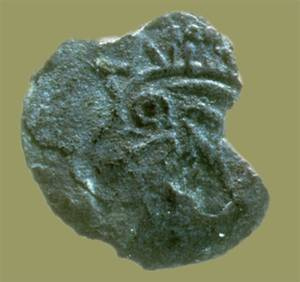
in 1957, amateur archeologist Guy Mellgren unearthed an unusual coin in the central Maine coast. The coin was eventually determined to be a medieval Norse penny, found in a large Native American settlement at the site.
So the question becomes….how did a Norse penny end up on the Maine coast, in a large Native American settlement? Is it possible the Norse visited the area before Columbus? Could the Norse, in fact, have been trading with the Native Americans?
A more likely scenario for the coin involves the trade routes of the time. The area was a central hub for trade, including trade with the Great Lakes area. It is probably more likely that the coin found its way from L’Anse aux Meadows in Newfoundland (a known Norse settlement) through routine trade to the Native American village. Still, it’s an interesting thought, isn’t it?
The Tecaxic-Calixtlahuaca Head
In 1933, archeologist Jose Garcia Payon discovered an interesting burial site. Located under a pyramid like structure, with other grave goods (including gold, copper, turquoise, pottery, and the like) Payon found a small, terracotta head shaped in the Roman style. The grave was dated to 1476-1510 A.D. This begs the question: how did a Roman artifact find its way into a Mexican burial in the late 1400s? Could this head, if indeed Roman in origin, indicate a pre-Columbian
Trans-Atlantic contact?

Are there alternative theories for the presence of the head? Possibly: some believe the head is a hoax, planted at the dig site. Or, perhaps, a mistakenly introduced artifact (although that hypothesis seems like a stretch to me). More likely would be that the head made its way to Mexico via trade, although again….that’s quite a journey.
So there you have it, ATS....three items out of time. Hope you enjoyed it!
Today I bring you another set of mysteries….objects discovered “out of time.” In other words, objects found in seemingly impossible circumstances that would date the object to antiquity or imply contact between nations before known contact existed. Before I began, let me assure you that yes, I’m aware these objects have been discussed before on ATS. However, this thread is meant to be a summary of these unusual objects and to provide an opportunity for our newer members to learn about them.
First up…The Antikythera Mechanism

The Antikythera Mechanism was discovered in 1901 in the wreckage of a ship off the isle of Antikythera. The ship supposedly sank in 87
BCE, and is believed to be of Greek origin. The Mechanism is thought to have been used to calculate the movement of the moon and stars. Some have even called it the “first analog computer known to man.”
X-rays of the device have indicated that there are at least 30 different gears present in it. British historian Derek Price has done extensive research on what the antikythera mechanism may have been used for. It was not until 1959 that Price put forth the theory that the device was used in astronomy to make calculations and predictions. In 1974, Price presented a model of how the antikythera mechanism might have functioned. When past or future dates were entered into the device it calculated the astronomical information related to the Sun, Moon, and other planets.
There is no question about the authenticity of the Antikythera Mechanism, and scientists continue to study it today.
Next up….The Goddard Norse Coin (aka the Maine Penny)

in 1957, amateur archeologist Guy Mellgren unearthed an unusual coin in the central Maine coast. The coin was eventually determined to be a medieval Norse penny, found in a large Native American settlement at the site.
This identification was confirmed in 1979 by Kolbjørn Skaare, a leading authority on Medieval Norse coinage, who examined the coin at the Maine State Museum and arranged for neutron activation testing of a small fragment from it. Skaare's analysis confirmed the coin's authenticity as a Norwegian penny issued during the first half of King Olaf Kyrre's reign, AD 1065-1080. The Goddard coin remains the only pre- Columbian Norse artifact generally regarded as genuine found within the United States.
So the question becomes….how did a Norse penny end up on the Maine coast, in a large Native American settlement? Is it possible the Norse visited the area before Columbus? Could the Norse, in fact, have been trading with the Native Americans?
A more likely scenario for the coin involves the trade routes of the time. The area was a central hub for trade, including trade with the Great Lakes area. It is probably more likely that the coin found its way from L’Anse aux Meadows in Newfoundland (a known Norse settlement) through routine trade to the Native American village. Still, it’s an interesting thought, isn’t it?
The Tecaxic-Calixtlahuaca Head
In 1933, archeologist Jose Garcia Payon discovered an interesting burial site. Located under a pyramid like structure, with other grave goods (including gold, copper, turquoise, pottery, and the like) Payon found a small, terracotta head shaped in the Roman style. The grave was dated to 1476-1510 A.D. This begs the question: how did a Roman artifact find its way into a Mexican burial in the late 1400s? Could this head, if indeed Roman in origin, indicate a pre-Columbian
Trans-Atlantic contact?

“An assessment of the case was made in 2001 by Romeo H. Hristov of University of New Mexico and Santiago Genovés T. of National Autonomous University of Mexico. This result clears up the doubts of Colonial manufacture of the artifact, and makes the hypothesis of Roman origin –among other possibilities- applicable.
The identification of the head as Roman work from the II-III century A.D. has been further confirmed by Bernard Andreae, a director emeritus of the German Institute of Archaeology in Rome, Italy. According to Andreae "[the head] is without any doubt Roman, and the lab analysis has confirmed that it is ancient. The stylistic examination tells us more precisely that it is a Roman work from around the II century A.D., and the hairstyle and the shape of the beard present the typical traits of the Severian emperors period [193-235 A.D.], exactly in the ‘fashion’ of the epoch."
On the other hand, an examination of the field notes of the archaeologist in charge of the excavation as well as the site itself have not revealed, in either case, signs of possible disturbances of the context (Hristov and Genovés 1999). A thermoluminescence test performed in 1995 by P. Schaaf and G.A. Wagner in the FS Archäometrie unit in Heidelberg, Germany, established its age range to somewhere between the 9th century BC and the middle of the 13th century AD, confirming its pre-colonial provenance.
However, Schaaf and Wagner have objected to the way the dates were described by Hristov and Genoves. Bernard Andreae of the German Institute of Archaeology in Rome, Italy, who examined photographs of the artifact, stated that he believed that it was Roman and proposed the 2nd century AD as its date of origin, based on the hairstyle and the beard.”
Are there alternative theories for the presence of the head? Possibly: some believe the head is a hoax, planted at the dig site. Or, perhaps, a mistakenly introduced artifact (although that hypothesis seems like a stretch to me). More likely would be that the head made its way to Mexico via trade, although again….that’s quite a journey.
So there you have it, ATS....three items out of time. Hope you enjoyed it!
Thanks for the great thread Smyleegirl, I love oop oot artifacts.
Have you read any of Michael Cremo's work? (Hidden Archaeology, Hidden History, etc). He covers a lot of things that have been covered up by the mainstream media. The archaeological establishment, really doesn't like when anything that challenges the statue quo, and takes great lengths to discredit or disparage anyone who finds analogous or challenging artifacts.
I, for one, whole heartedly believe that we have been here for a lot longer than the establishment lets on, and that we have a much more convoluted history. Civilizations didn't start a few thousand years ago. I feel our history is far more complex!
Have you read any of Michael Cremo's work? (Hidden Archaeology, Hidden History, etc). He covers a lot of things that have been covered up by the mainstream media. The archaeological establishment, really doesn't like when anything that challenges the statue quo, and takes great lengths to discredit or disparage anyone who finds analogous or challenging artifacts.
I, for one, whole heartedly believe that we have been here for a lot longer than the establishment lets on, and that we have a much more convoluted history. Civilizations didn't start a few thousand years ago. I feel our history is far more complex!
reply to post by rimjaja
I've not read anything by this author, thanks for the suggestion! I will absolutely check him out.
I've not read anything by this author, thanks for the suggestion! I will absolutely check him out.
New here, so thanks for thinking of us. I haven't heard of the Norse coin,
the untold history is my biggest conspiracy theory.
Like the perfect stone cuts with tool marks, they discovered a water mill
that would've been attached to a saw blade, for cutting stone! Yet they
tell us it was stone, and copper tools.
They found ancient cranes, or blueprints more accurately, maybe stories
is accurate. Anyway they built some, and moved, and sit 5 ton blocks with
ease.
If they would've said they had this technology, or suspected it if for some reason
they thought people would give them a hard time, we all could have been spared
the ancient alien theory.
Appreciate that one archaeologist of the world.
the untold history is my biggest conspiracy theory.
Like the perfect stone cuts with tool marks, they discovered a water mill
that would've been attached to a saw blade, for cutting stone! Yet they
tell us it was stone, and copper tools.
They found ancient cranes, or blueprints more accurately, maybe stories
is accurate. Anyway they built some, and moved, and sit 5 ton blocks with
ease.
If they would've said they had this technology, or suspected it if for some reason
they thought people would give them a hard time, we all could have been spared
the ancient alien theory.
Appreciate that one archaeologist of the world.
reply to post by smyleegrl
Check out the near mythical "viking navigation sunstone lens."
Supposedly they refracted light in such a way as to give the vikings the ability to navigate the ocean using the suns position-nothing spectacular there I hear you say...
But these lenses allowed you to do this even with thick cloud or fog,thus becoming very useful,and very before their time.
cosmiclog.nbcnews.com...
en.wikipedia.org...
Wow-even todays computers cannot improve upon their performance...How the heck did the vikings make these things?
Check out the near mythical "viking navigation sunstone lens."
Supposedly they refracted light in such a way as to give the vikings the ability to navigate the ocean using the suns position-nothing spectacular there I hear you say...
But these lenses allowed you to do this even with thick cloud or fog,thus becoming very useful,and very before their time.
cosmiclog.nbcnews.com...
The lenses are bi-aspheric and have excellent imaging properties. Their surface appears to be an oblate ellipse, while the surface nearest the eye approaches a parabola. They are so well produced that even computer optimisation has not been able to improve their performance
en.wikipedia.org...
Wow-even todays computers cannot improve upon their performance...How the heck did the vikings make these things?
This is a very fascinating little aspect of archaeology! I was always intruiged with these out-of-place-artifacts.
I am convinced that there is an explanation for most of them, but it doesn´t change the fact that some of them remain unsolved.
Great topic!
I am convinced that there is an explanation for most of them, but it doesn´t change the fact that some of them remain unsolved.
Great topic!
The Bagdad battery also springs to mind-some futuristic tesla type guy must have invented these-but in 200BC!!!
news.bbc.co.uk...
Cool or what?
Some folks also think these could be ancient Egyptian lightbulbs:
Or the famous Inca planes?
Tested in a wind tunnel,and yep-they fly!
And the baigong pipes of China,although they may be a natural formation.
en.wikipedia.org...
news.bbc.co.uk...
Cool or what?
Some folks also think these could be ancient Egyptian lightbulbs:
Or the famous Inca planes?
Tested in a wind tunnel,and yep-they fly!
And the baigong pipes of China,although they may be a natural formation.
en.wikipedia.org...
Originally posted by Silcone Synapse
reply to post by smyleegrl
Check out the near mythical "viking navigation sunstone lens."
Supposedly they refracted light in such a way as to give the vikings the ability to navigate the ocean using the suns position-nothing spectacular there I hear you say...
But these lenses allowed you to do this even with thick cloud or fog,thus becoming very useful,and very before their time.
cosmiclog.nbcnews.com...
The lenses are bi-aspheric and have excellent imaging properties. Their surface appears to be an oblate ellipse, while the surface nearest the eye approaches a parabola. They are so well produced that even computer optimisation has not been able to improve their performance
en.wikipedia.org...
Wow-even todays computers cannot improve upon their performance...How the heck did the vikings make these things?
You shouldn't believe everything you read.
The Vikings used a common calcite crystal - called Icelandic Spar.
You can pick one up off the ground and use it to find the Sun on any cloudy day.
This form of calcite polarizes the light, eliminating a lot of the scattering of the Sun's rays that clouds do.
Really.
Harte
EDIT: Re your other post, here's some info you probably are unaware of: link
H.
edit on 4/6/2013 by Harte because: (no reason given)
reply to post by Silcone Synapse
I hate when people say the Baghdad battery is for storing papers.
If this is the case why the copper lining, and iron rod?
Plus acidic residue, really? Don't these people realizes that would be a
horrible container for storing writings, and that our ancestors just wasn't
that stupid?
I hate when people say the Baghdad battery is for storing papers.
If this is the case why the copper lining, and iron rod?
Plus acidic residue, really? Don't these people realizes that would be a
horrible container for storing writings, and that our ancestors just wasn't
that stupid?
This one is possibly the most mind boggling of all.
They are human footprints,in what has now become rock,which date back to the Permian age.
That was 298million years-250million years ago.
Let that sink in.
Who the heck was that?A human?A God?An alien?
250 million years ago,walking in the mud...
www.ancient-wisdom.co.uk...
Great oopart site that one.
They are human footprints,in what has now become rock,which date back to the Permian age.
That was 298million years-250million years ago.
Let that sink in.
Who the heck was that?A human?A God?An alien?
250 million years ago,walking in the mud...
In 1987, not far from the Zapata track site, paleontologist Jerry MacDonald discovered a variety of beautifully preserved fossil footprints in Permian strata.
www.ancient-wisdom.co.uk...
Great oopart site that one.
edit on 6/4/2013 by Silcone Synapse because: image not working?weirdness
Originally posted by Harte
The Vikings used a common calcite crystal - called Icelandic Spar.
You can pick one up off the ground and use it to find the Sun on any cloudy day.
This form of calcite polarizes the light, eliminating a lot of the scattering of the Sun's rays that clouds do.
Really.
Harte
Ah,cheers-seems I have only read the over hyped info on that one then.
I shall have to aqquire a bit of the calcite crystal and have a go myself.
reply to post by Silcone Synapse
Yes!!! The foot prints is the biggest cover up of all time!
I believe in evolution, and from what I understand 700,000 years
is not nearly enough time for evolution, especially the human brain.
We've been here a long time lots of evidence to support this, yet science
won't budge.
Gotta ask, why the cover up? What technology is it they don't want us know about,
or do they just want to believe that with technology man can't be brought to
near extinction? Which is what I believe happened to the millions of year old
story of man.
Yes!!! The foot prints is the biggest cover up of all time!
I believe in evolution, and from what I understand 700,000 years
is not nearly enough time for evolution, especially the human brain.
We've been here a long time lots of evidence to support this, yet science
won't budge.
Gotta ask, why the cover up? What technology is it they don't want us know about,
or do they just want to believe that with technology man can't be brought to
near extinction? Which is what I believe happened to the millions of year old
story of man.
I've read quite a few threads on out of place objects & they are all really interesting reads,the bagdad battery & footprint are pretty interesting
as is the The Antikythera Mechanism.
I'm sure there are alot more objects out there somewhere that we haven't found that reveal alot about our past,the trouble is once the major players get hold of them it's the last we hear of them.
Humans go back a long way but for whatever reason we're not allowed to find out how far..strange
I'm sure there are alot more objects out there somewhere that we haven't found that reveal alot about our past,the trouble is once the major players get hold of them it's the last we hear of them.
Humans go back a long way but for whatever reason we're not allowed to find out how far..strange
one of my fave subjects next to ancient aliens
S&F
ETA: dont forget the Egyptian Lightbulb, Dendera Egypt
Dendera Lightbulb
S&F
ETA: dont forget the Egyptian Lightbulb, Dendera Egypt
The Ancient Egyptian Light bulb Many researchers in history have brought evidences forward that challenge or even destroy orthodox beliefs. Erich Von Daniken is one of those researchers bringing revelations such as the Ancient Egyptian Light bulb into the light challenging the orthodox belief that Thomas Edison invented the light bulb and Direct Current. In September 1996 the American Broadcasting Company (ABC) aired a documentary based on Erich’s book, “Chariots of the Gods?” entitled, “Chariots of the Gods? The mystery continues”. Within the documentary dramatic video footage was shown that revealed hieroglyphs in central Egypt that resembled a transparent glass tube with a form within it that had the likings of a serpent, obviously representing some kind of light source. Erich was curious if it worked so he took extensive notes of these hieroglyphs and had the light bulb built to “ancient Egyptian” specifications. When powered up, it emitted light. It was indeed a light bulb and it worked. The ancient Egyptians also had a Direct Current (DC) battery.
Dendera Lightbulb
edit on 4/6/2013 by HomerinNC because: (no reason given)
Love this field but sadly most OOPART's are lost or DELIBERATELY destroyed but what about the Klerksdorp spheroids or the metal cube that nearly
destroyed a mining tool in a Swiss salt mine in the 1970's,.
The Coso Geode though is definitely a Champion spark plug circa 1920 but that leave's many other's such as those you have posted here that can not be easily explained away.
The Coso Geode though is definitely a Champion spark plug circa 1920 but that leave's many other's such as those you have posted here that can not be easily explained away.
edit on 6-4-2013 by LABTECH767 because: (no reason given)
edit on 6-4-2013 by LABTECH767 because: (no
reason given)
I would definitely recommend America B.C. (it's a book!). There's much more out there than is let on. It's insane that they still teach Columbus as
the first westerner to discover the Americas. Besides, he was a complete t'wat.
reply to post by Silcone Synapse
Here are some more footprint's (even if you aren't a creationist just reinterpret them along scientific line's).
www.bible.ca...
www.angelfire.com...
www.genesispark.com...
www.thelivingmoon.com...
creation.com...
I read about some test's conducted on the grain's in the stone by a cross section of a footprint from, a dinosaur trackway that was about size 11 and the grain compression shown in the fossilised strata showed that the creature walked like a human with the same weight distribution and compression to a modern footprint, it was taken from a freshly exposed section were the overlying sandstone was removed revealing the fresh track's then it was cut out of the surrounding stone for test's.
the stride was comparable to a modern human as well.
Fossilised finger.
paleo.cc...
www.creationevidence.org...
Ancient wall's.
www.s8int.com...
s8int.com...
Here are some more footprint's (even if you aren't a creationist just reinterpret them along scientific line's).
www.bible.ca...
www.angelfire.com...
www.genesispark.com...
www.thelivingmoon.com...
creation.com...
I read about some test's conducted on the grain's in the stone by a cross section of a footprint from, a dinosaur trackway that was about size 11 and the grain compression shown in the fossilised strata showed that the creature walked like a human with the same weight distribution and compression to a modern footprint, it was taken from a freshly exposed section were the overlying sandstone was removed revealing the fresh track's then it was cut out of the surrounding stone for test's.
the stride was comparable to a modern human as well.
Fossilised finger.
paleo.cc...
www.creationevidence.org...
Ancient wall's.
www.s8int.com...
s8int.com...
edit on 6-4-2013 by LABTECH767 because: (no reason given)
reply to post by Silcone Synapse
The Ceremonial arrow head's, now imagine the spiral pattern's represent thrust and the front was on a joint and could swing under, the wing's could fold and then compare it to this image purportedly of the Black night satellite that someone at NASA had a space mission intercept and photograph,.
www.bing.com...=detail&id=CE5ECE87D2C9C45701CFDABAA6FAA400E7C6 78C8&selectedIndex=15
If it is then it is the ultimate oopart.
Some of these picture's on this are dis info but this is one of the original's that has been up for year's
Thanks smyleegrl for this great thread a definite pandora's box let's hope we like what we find.
The Ceremonial arrow head's, now imagine the spiral pattern's represent thrust and the front was on a joint and could swing under, the wing's could fold and then compare it to this image purportedly of the Black night satellite that someone at NASA had a space mission intercept and photograph,.
www.bing.com...=detail&id=CE5ECE87D2C9C45701CFDABAA6FAA400E7C6 78C8&selectedIndex=15
If it is then it is the ultimate oopart.
Some of these picture's on this are dis info but this is one of the original's that has been up for year's
Thanks smyleegrl for this great thread a definite pandora's box let's hope we like what we find.
edit on 6-4-2013 by LABTECH767 because: (no
reason given)
edit on 6-4-2013 by LABTECH767 because: (no reason given)
Great thread. I always wonder about our missing flawed and covered up history. The ancient indian "Vimanas" is something that fascinates me. The
antikythera mechanism is amazing! Thanks for posting
new topics
-
Morning’s Reverie
Short Stories: 2 hours ago -
Democrat county officials openly declare intention to commit ballot fraud in PA
2024 Elections: 5 hours ago -
DefCon Teetering on Escalation
World War Three: 7 hours ago -
What is your most awesome achievement or proudest moment, RE: something you were responsible for?
General Chit Chat: 10 hours ago -
Whistleblower warns FBI can’t be trusted with background checks for Trump’s nominees
Whistle Blowers and Leaked Documents: 11 hours ago
top topics
-
DefCon Teetering on Escalation
World War Three: 7 hours ago, 27 flags -
Incoming TRUMP Admin will Declare a National Emergency to Mass Deport People Here Illegally.
Social Issues and Civil Unrest: 12 hours ago, 18 flags -
Whistleblower warns FBI can’t be trusted with background checks for Trump’s nominees
Whistle Blowers and Leaked Documents: 11 hours ago, 16 flags -
Democrat county officials openly declare intention to commit ballot fraud in PA
2024 Elections: 5 hours ago, 12 flags -
What is your most awesome achievement or proudest moment, RE: something you were responsible for?
General Chit Chat: 10 hours ago, 9 flags -
Like a Phoenix from the Ashes Notre-Dame Cathedral re-opens Next Month
Other Current Events: 12 hours ago, 6 flags -
Morning’s Reverie
Short Stories: 2 hours ago, 3 flags
active topics
-
Morning’s Reverie
Short Stories • 1 • : JJproductions -
-@TH3WH17ERABB17- -Q- ---TIME TO SHOW THE WORLD--- -Part- --44--
Dissecting Disinformation • 3301 • : brewtiger123 -
Democrat county officials openly declare intention to commit ballot fraud in PA
2024 Elections • 8 • : WeMustCare -
Incoming TRUMP Admin will Declare a National Emergency to Mass Deport People Here Illegally.
Social Issues and Civil Unrest • 90 • : WeMustCare -
60s-70s Psychedelia
Music • 59 • : Hellmutt -
WATCH LIVE: US Congress hearing on UFOs, unidentified anomalous phenomena
Aliens and UFOs • 129 • : putnam6 -
DefCon Teetering on Escalation
World War Three • 22 • : Astrocometus -
Tesla cutting 14,000 jobs
Global Meltdown • 56 • : annonentity -
What is your most awesome achievement or proudest moment, RE: something you were responsible for?
General Chit Chat • 18 • : Lumenari -
Though about history, this post is relevant to where DEI may be taking us. Short read.
Social Issues and Civil Unrest • 10 • : Solvedit



